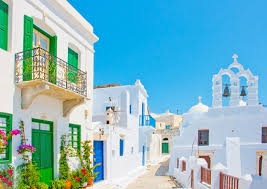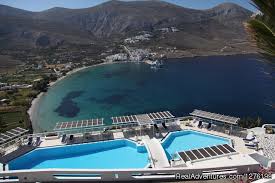General Information Amorgos is an island with white houses, crystal clear water and a peaceful atmosphere: it is no coincidence that Luc Besson chose to shoot the first part of the film The Big Amorgos GreeceBlue here. Once only visited by the occasional backpacker, Amorgos has become quite an “trendy” island since the film was released, and it is no surprise that you will find more French holidaymakers here than usual. It is one of the the easternmost islands of the Cyclades, located southeast of Naxos, Ios northeast of Ios and north of Anafi. The coastline is 112 kilometres. Amorgos is generally mountainous, rocky and rough, with very few residents and high hills and mountains, the highest are Mt Krikello (826 m) and Mt Saint Elias (648 m) .
The people engaged in agriculture, fisheries and shipping. The few products of Amorgos are cereals, wine, oil, figs and tobacco all excellent especially the tobacco and beans are in demand. Also fine are the dairy products. In recent years, the beauties of Amorgos are attracting more and more Greeks and foreign tourists.
Amorgos is by no means a commercialised island, though, and it is truly an excellent place for relaxing. Its rather harsh, mountainous surroundings are beautiful in a clean and dramatic way, and in the valleys there are hundreds of flowers and trees.
Even though it is a very small island, there are quite a few things to see. The locals are very friendly and they are working hard to make the island look its best at the beginning of each season.
Amorgos History: Before getting its current name, Amorgos was called Minoa, which indicates that the Minoan, Cretan, civilization once had a foothold here. There were probably people here even before then, since archaeological findings on the island date as far back as the 4th Millennium BC.
During the Classical Age, the island traded with many islands and city states on the mainland, and its linen was the island’s pride.
In 1207 the Aegean Duchy under the Venetian Marcus Sanoudos included Amorgos, and the Venetians were to rule the island until the Turkish takeover in the 15th century. During this period not many people lived on the island, and apart from the Turkish enslavement they had to suffer constant pirate raids.
Amorgos was one of the first islands to be freed after the War of Independence had broken out in 1821.
One of the worst periods for Amorgos was during the Second World War, when the island was totally isolated and many locals starved to death. Only recently, with the increase of tourism on the island, has Amorgos started to take off and some of the islanders have moved back from the mainland.
What to See Rent a car or a bike and visit the small villages. The capital, Chora, is a very quiet village with about 500 inhabitants. It is situated high up in the mountains, and the road is long and winding. You’ll have to park outside Chora. Even though it is so small, there is quite a few little taverns and cafes. This is truly a place where the time has stopped, and thanks to local regulations, the architecture is kept in the traditional style. There is a church attached to the cliff, and the locals are also proud to have Greece’s smallest church here – with room for only three!!! There is also a museum as well as a Venetian Citadel from the 13th century.
Katapola is a village next to the sea with lovely little fish taverns along the harbour. You’ll se fish trying to get some bread in the crystal waters and there is a tiny beach here. From here you can get to the monastery Chozoviotissa which definitely is worth visiting. According to tradition it was built in the 9th century after a ship had sunk just outside Amorgos carrying an icon of the Virgin Mary, or Panagia (all saint) as she is called in Greek.
With a little luck the monks will offer you some local liqueur. To get to Chozoviotissa you’ll have to climb many steps.
The ancient capital of the island, Minoa, is situated on a high cliff above Katapola. There are still ruins there from classical and Roman times.
Aegiali is a pretty village built on a thin strip between the mountain and the sea. There are few shops, cafes and taverns here worth a visit.
The village Potamos is built just above Aegiali, and the two villages pretty much seem like one. In Potamos you can stroll around in the little winding streets that were built that way to confuse the pirates.



